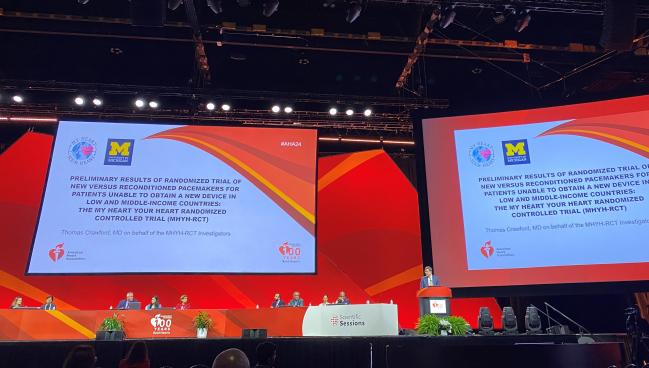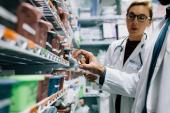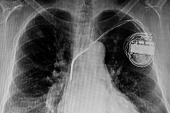Infections No More Likely With Reconditioned Versus New Pacemakers
Many hope My Heart Your Heart will catalyze an effort to help patients worldwide who need but can’t afford these devices.

CHICAGO, IL—Reconditioned pacemakers carry the same low infection rate as new devices out to 90 days, according to preliminary data from the international My Heart Your Heart trial.
The findings should help alleviate stigma associated with the practice of donating recycled devices to be used in lower-resource countries where patients might otherwise go untreated, the study’s researchers say.
Clinicians have been sending expired or reconditioned devices and donating their time to clinics in other countries for years, but the practice has required jumping regulatory and ethical hurdles as well as overcoming cost and perception barriers. Generally, this practice requires export permits from the US Food and Drug Administration plus a stamp of approval from the country to which the devices are being given.
“While in the United States we implant about 800 devices per million of the population annually, in many countries of the global south especially, the implantation rate is in the single digits,” said Thomas Crawford, MD (University of Michigan, Ann Arbor), who presented the findings in a late-breaking trials session at the American Heart Association 2024 Scientific Sessions. The reasons for this are multifactorial, he explained, including the cost of the device and access to healthcare.
“It is clear that innovative solutions are needed to begin to address this disparity and to prevent deaths that are preventable,” Crawford continued. “We strongly believe that postmortem reuse of pacemakers has a real chance of bridging the gap and saving countless lives.”
These findings are the first step toward changing opinions around the practice of device reuse, said Xavier Jouven, MD, PhD (Paris Cardiovascular Research Center, Inserm, France), who discussed My Heart Your Heart during the session. “Device donation is something that can be seen as a poor approach, but it’s exactly like organ donation. Organ donation is a very positive action. . . . We have to change the perception from fear of infection to waste reduction,” he argued, calling upon international societies to publish new recommendations on the topic.
Commenting on the findings for TCTMD, James Kirkpatrick, MD (UW Medical Center, Seattle, WA), who published a similar study in 2010, said the taboo around device reuse likely comes from FDA rules as well as laws in foreign countries prohibiting this practice. But these regulations are all “theoretical” and not based in data, he said. “Now we have data that suggests otherwise,” he said. “I would suspect that the FDA is probably not going to retake up this issue [within the US] to try to reverse course even with this because I think it’s for the most part only going to be applied in countries in which resource limitations are there.”
Similar Infection Rates
For the study, Crawford and colleagues enrolled 298 patients with a class I indication for a pacemaker and no financial means to acquire a new device as assessed by a social worker. Patients were randomized to receive either a new or reconditioned pacemaker at one of seven hospitals in Venezuela, Nigeria, Paraguay, Kenya, Mozambique, or Mexico between May 2022 and June 2024. Mean patient age was 69.5 years in the new cohort and 72.1 years in the reconditioned cohort, and 47.9% and 51.4% of participants, respectively, were male. Just over three-quarters of patients had complete heart block, and about one-quarter of patients had sinus node dysfunction.
All reconditioned devices had an estimated remaining battery length of at least 4 years, with Crawford reporting that the device with the least longevity in the study was about 6-7 years. They were decontaminated, tested, and sterilized through a standardized process with World Medical Relief, a Michigan-based nonprofit that distributes surplus medical supplies internationally, and Northeast Scientific, a Connecticut-based medical device remanufacture company.
At 90 days, the rate of any infection was 2.9% and 1.5% in the new and reconditioned pacemaker groups, respectively, which met the criteria for noninferiority with a margin of 5%. Infections led to device removal and resolved with antibiotics in 2.2% and 1.5% of those who received new and reconditioned devices, and 0.7% of the infections in the new pacemaker group had cellulitis that resolved with antibiotics (P = NS for all comparisons).
Secondary endpoints of lead dislodgement (5.0% vs 7.3%), pacemaker removal (2.2% vs 1.5%), and death (0 vs 2.2%) were similar between the new and reconditioned arms. None of the deaths were related to the device; rather, the causes included COVID-19, acute renal failure, pulmonary embolism, and ventricular tachycardia.
Crawford acknowledged that a larger sample size could have “revealed rare causes of device failure or other patient harm” and that enrollment was not balanced across the multiple hospitals.
“With the help of this trial, we hope that we might be able to scale up the reprocessing operation on charitable grounds and be able to deliver pacemakers to patients in low- and middle-income countries free of charge,” he said, adding that this will take collaboration and infrastructure to move forward.
Speaking with TCTMD, Northeast Scientific CEO Craig Allmendinger said his company’s primary business has revolved around reprocessing complex interventional catheters, but added that the company was inspired by Crawford’s efforts with My Heart Your Heart to begin repurposing pacemakers. Northeast Scientific donates all time and costs associated with the project.
Allmendinger estimates the project has reprocessed close to 2,000 pacemakers in 2024 alone, with hopes to scale that in the future by constructing a dedicated facility staffed by volunteers. While it’s possible they could take on the more complex task of recycling ICDs in the future, pacemakers are really the “low-hanging fruit,” Allmendinger said. “We don’t want to get into really complex reprocessing beyond pacemakers until we have the resources to do that.”
Many, Many Barriers
Cost will be a significant barrier to this endeavor, even though the reconditioned devices themselves are cheaper.
The price to recondition a single pacemaker likely falls between $50 and $100, plus an additional $150 to $200 per new lead needed. But “in the United States, the cost of a pacemaker is generally about $6,000 or so,” Crawford said, adding that each lead costs about an additional $500. “In much of the global south, it’s about $2,000 that people have to pay. And so it is substantial savings.”
The My Heart Your Heart project has been entirely donation- and volunteer-based with no patients paying anything for their devices, though some study hospitals did charge a small fee for use of their operating room, he specified. Hospitals themselves are required to have fluoroscopy or X-ray equipment, running water, and personnel with expertise, all of which cost money.
The need to improve education and increase awareness is another obstacle for the project, according to Crawford. “In many of these countries, the physician has to bring the concept out of the blue and say, ‘Hey, there’s such a device that can actually make you feel better and can make you live longer. You’ve never heard of it, but believe me, we got one from a deceased person in the United States. Here it is.’”
Even diagnosing heart failure in the first place needs improvement in some regions in order to identify patients who would benefit from pacemakers, Crawford told TCTMD. He explained that when he started the pilot project in 2018 in Sierra Leone, no patients had ever received a pacemaker there. Rather, those with money would travel to Ghana for diagnosis and treatment with one of only two practicing cardiologists.
Perhaps the biggest hurdle, though, will be overcoming individual governmental regulations. The “random assortment” of countries that were included in the trial was a result of the fact that the researchers were able to connect with physicians who not only had implantation skills but also were able to petition their governments to allow the project to happen, Crawford explained.
“Understandably, institutions are risk-averse, and it’s not something that’s legal anywhere in the world, even though it happens in most countries,” he said. One of the hospitals they approached for the study turned it down because they had been implanting reconditioned pacemakers for decades already, Crawford noted. “They said: ‘We don’t want to ask the government, because we’ve been doing it for 30 years. What if they say no?’”
‘Walking the Walk’
Jouven stressed the importance of these findings for the “thousands of subjects who are dying because they cannot afford a pacemaker.”
Kirkpatrick agreed. “To actually show this really establishes that the practice that has been going on is not worrisome or somehow compromising safety for patients,” he said. “One of the reasons that this is particularly important is that the WHO and other groups have really argued mostly on moral and ethical grounds that we should not be compromising quality in devices or anything else in countries that are resource-limited. We should hold ourselves to the same standards.”
Commenting during a press conference, Miguel Leal, MD (Emory School of Medicine, Atlanta, GA), commended the researchers for an impactful project. “In an era where it’s so difficult to promote equitable access and a little bit of social justice in the middle of medical care, this is a great example of walking the walk and not just talking the talk,” he said.
The increasing longevity of pacemakers made over the last few years means that often patients require an upgrade to a defibrillator or cardiac resynchronization device before their pacemaker reaches the end of its usefulness. “We as clinicians are faced with the dilemma of having to remove a pacemaker that has been in this patient for approximately 7 or 8 years, which is barely halfway into the battery life of that device, and dispose of it,” Leal explained, adding that “legacy technologies” are also sitting on US hospital shelves as new iterations of these devices have come out.
When it comes to infection related to pacemaker implantation, he said that much of the risk comes from how the device is implanted rather than the device itself. “Careful surgical technique will take care of the infection risk and keep it acceptably low,” Leal added, clarifying that this is around 1-1.5%.
He hopes the My Heart Your Heart project will serve as a catalyst for building up this kind of device reuse, to both improve global care and reduce waste. Previous efforts in this space have “been quiet, mostly due to regulatory issues and also due to the fear that this could lead to some kind of consequence,” Leal said. “Studies like [this] are showing [that it] may not necessarily be the case at all—quite the opposite.”
Yael L. Maxwell is Senior Medical Journalist for TCTMD and Section Editor of TCTMD's Fellows Forum. She served as the inaugural…
Read Full BioSources
Crawford T. Preliminary results of randomized trial of new versus reconditioned pacemakers for patients unable to obtain a new device in low and middle-income countries: the My Heart Your Heart randomized controlled trial (MHYH-RCT). Presented at: AHA 2024. November 17, 2024. Chicago, IL.
Disclosures
- Crawford and Kirkpatrick report no relevant conflicts of interest.





Comments